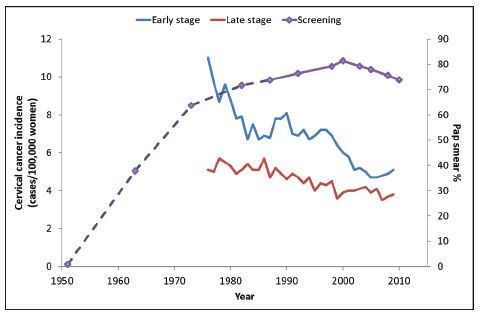(P002) Impact of Three Decades of Screening on Cervical Cancer Incidence
Effective cancer screening should detect disease at an earlier, more curable stage and thus reduce the incidence of late-stage diagnosis. In the last 3 decades, the Pap smear has become widely practiced in the US and is effective in the early diagnosis and prevention of cervical cancers.
P002: Figure

Daniel X. Yang, BS, Cary P. Gross, MD, Pamela R. Soulos, MPH, James B. Yu, MD; Yale University School of Medicine; Cancer Outcomes, Public Policy, and Effectiveness Research (COPPER) Center at Yale
Background: Effective cancer screening should detect disease at an earlier, more curable stage and thus reduce the incidence of late-stage diagnosis. In the last 3 decades, the Pap smear has become widely practiced in the US and is effective in the early diagnosis and prevention of cervical cancers. However, the overall number of cases of cervical cancer prevented by screening is unknown.
Methods: We obtained cervical cancer incidence data strongning 1976 to 2009 from the Surveillance, Epidemiology and End Results (SEER) database. Additionally, screening utilization data from 1951 to 2010 were obtained from literature reports and from the National Cancer Institute (NCI) Progress Reports. We examined trends in early (localized)- and late (regional, distant)-stage cancer incidence and sought to estimate the number of cancers prevented due to screening over the past 3 decades.
Results: From 1951 to 1973, there was a steady increase in screening utilization. Screening rates rose from under 1% in 1951 to 63.7% in 1973. However, over the past 3 decades, the percentage of adult women who received cervical cancer screening remained steady at 71.7% in 1982 and rising to 73.8% in 2010. From 1976 to 2009, there was a statistically significant decrease in the incidence of early-stage cervical cancer, from 10.2 cases to 5.4 cases per 100,000 women (P < .001). Late-stage disease incidence also decreased from 5.2 cases to 3.7 cases per 100,000 women (P < .001). After adjusting for “prescreening era” rates of cervical cancer, we estimated that Pap smears were associated with a reduction of between 102,000 and 452,000 cases of cervical cancer over the past 3 decades in the US.
Conclusions: There has been a statistically significant decline in both early- and late-stage cervical cancer incidences during an era of widespread screening.